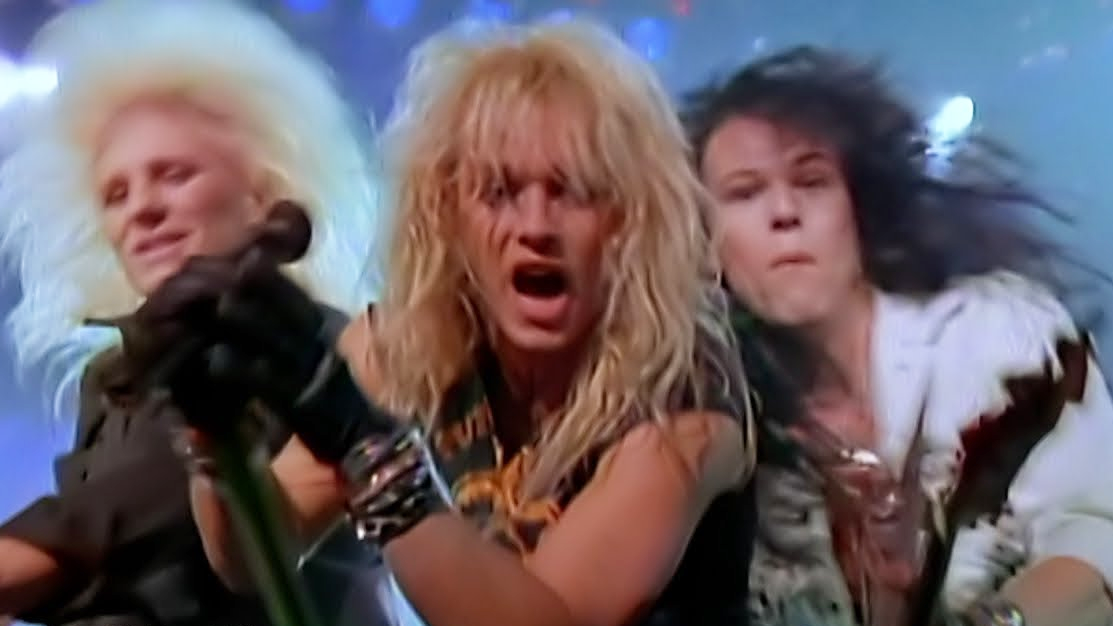May 8, 2024
Rock of Ages | June 6 - 30 | King's Wharf Theatre in Penetanguishene
May 1, 2024

L.A. rockers Poison, shown in their 1988 video for “Nothin’ But a Good Time”, used their “glam metal” image to achieve huge success in the 80s and sold 55 million albums worldwide.
Fans of arena rock who remember hits like “Cum On Feel the Noize”, “We’re Not Going To Take It” and “Don’t Stop Believin’” – all of which feature in the nostalgic musical Rock of Ages – will find that the new production at St. Jacobs Country Playhouse (May 8 to June 1) and King's Wharf Theatre (June 6 to June 30) has a familiar look.
The rock n’ roll fairytale is set in 1987, and its visual style is influenced by rock videos of the period, with pulsating, colourful lights, prolific smoke machines, and long, windswept locks.
The 1930s saw the “Golden Age of Radio”, with 80 percent of the U.S. population owning one of the devices. Over the next few decades, radio was the medium through which musicians became household names, often sight unseen.
The claim that “Video Killed the Radio Star” was probably premature, but the medium did siphon off listeners to a new entertainment format: the music TV channel.
MTV debuted at midnight on August 1, 1981 by playing English new wave band The Buggles’ biggest hit – what else? – and followed a similar chart format to the one whose demise it claimed to have brought about. Instead of disc jockeys, MTV used “veejays” to present videos of the hits.
While the first song it played was lightweight pop, MTV immediately showed its appreciation for heavier fare with its second video, “You Better Run” by Patricia Mae Giraldo, better known by her nom de rock, Pat Benatar.

Innovative music video channel MTV's opening shot on August 1, 1981 was out of this world, with the tagline “You’ll never look at music the same way again.”
Sherrie: Nobody cares about the opening act anyway. No offense!
Rock of Ages
But what started out as a musical marketing tool soon started to influence the core product itself.
Some rock bands, such as England’s Whitesnake, softened their appearance and sound in order to break through to a North American audience. Helped, no doubt, by a slick, glitzy video that showed lead singer David Coverdale backlit and in soft focus, the band’s “Here I Go Again” was a mega-hit in 1987. The single helped to shift 8 million copies of Whitesnake’s self-titled album, far outselling their previous seven LPs. The song was a sharp move away from their late-'70s, heavy rock style to one that was more commercially accessible. While they lost many of their traditional, hardcore fans, the huge number of new followers more than made up for their departure.
Dubbed "glam metal" in an attempt to deride it, this hugely impactful brand of rock enabled many bands to portray a more flamboyant and less controversial image. In an era of cultural excess, it proved to be a popular and lucrative strategy.
Videos with movie-level budgets by the likes of Poison, Mötley Crüe, Kiss, and Twisted Sister resonated with audiences and helped bands to fill stadiums.

Just a handful of the artists whose thunderous anthems feature in Rock of Ages.
Given the popularity of MTV’s 24-hour-a-day video rotation format, it’s no surprise that record companies decided to invest heavily in their artists’ small screen performances. Music videos could make or break a hit single and also affect subsequent album sales, so '80s' production budgets often reached well into seven figures.
In the Top 40 list of the most expensive music videos of all time, L.A.’s Guns N' Roses has the highest entry by a rock band at number 5, spending US$5,000,000 in 1993 to promote their single “Estranged”. That’s the equivalent of over US$10,000,000 today. The biggest budget to date is the US$7,000,000 (US$13,443,547, adjusted) spent on Michael Jackson and Janet Jackson’s “Scream” video in 1995. Madonna fills the top five’s other three spaces.

"Here am I sitting in a tin can, far above the world..." Canadian astronaut Chris Hadfield, shown here in a YouTube video, sang "Space Oddity" on the International Space Station.
Commander Chris Hadfield famously sang David Bowie’s “Space Oddity” while aboard the International Space Station in 2013, and a recording of the Canadian's performance went viral on YouTube, with an astronomical 52 million views. Launching Hadfield into space cost $20,000,000, which could, arguably, make that the most expensive music video in the world (and beyond).
28 years earlier, Starship lamented the loss of live-performance venues in Los Angeles while observing that “We Built This City” on rock n’ roll. Their music, and that of many other '80s rockers, also built a soundtrack for a lifetime of memories.
Whether it’s the over-the-top rock videos or the classic, blood-pumping anthems that move you, you’ll find "Nothin’ But a Good Time" in Rock of Ages.